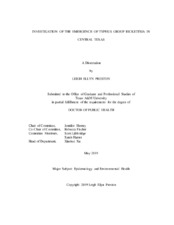| dc.description.abstract | Background: Typhus group rickettsia (TGR) can cause disease after exposure to Rickettsia typhi, or Rickettsia prowazekii, bacterium carried by fleas. Symptoms of TGR rickettsiosis are often non-specific, and there is evidence of the emergence of this pathogen in Texas. However, significant gaps in the knowledge of the epidemiology of disease exist. Methods: Using data from Baylor Scott & White (BSW) hospitals and clinics, caseseries and case-control analyses attempted to describe characteristics of diagnosed cases of acute TGR infections in central Texas and to model infection and make predictions about diagnosis. A laboratory investigation looked to identify potential animal reservoirs in Texas. Results: The case-series analysis revealed discrepancies in diagnostic criteria between physicians, state health authorities, and other research groups. The most commonly reported symptom was fever (87.5%), and the majority of patients were found to have acute liver injury (68.8%). Logistic regression models of TGR rickettsiosis patients compared to Rocky Mountain spotted fever (RMSF) patients revealed age (OR: 1.06; 95% CI: 1.01-1.10), acute liver injury (OR: 8.60; 95% CI: 2.06-35.96), and laboratory evidence of systemic infection (OR: 6.58; 95% CI: 1.21-35.89) to be associated with TGR diagnosis, while heart disease is more likely associated with RMSF diagnosis (OR: 0.13; 95% CI: 0.02-0.77). Comparing TGR rickettsiosis patients to patients testing negative for RMSF and TGR infections found living on a farm or ranch, or in a wooded area (OR: 31.05; 95% CI: 4.01- 240.17), acute liver injury (OR: 28.88; 95% CI: 3.46-241.14), and acute lung infection (OR: 17.78; 95% CI: 2.11-149.81) to be associated with TGR diagnosis. DNA extraction product from 238 skunks, 196 canines, seven opossums, five mice, two raccoons, and one rat were tested with quantitative real-time polymerase chain reaction (PCR), but did not show evidence of infection with R. typhi. Discussion: The challenge of confirming diagnosis of TGR infection makes characterizing, calculating prevalence, and modeling TGR infection difficult. Additionally, difficulty in identifying and describing infection in animal species contributes to gaps in epidemiological understanding of TGR rickettsiosis. Future research should involve active surveillance of patients and animal models of infection. | en |


